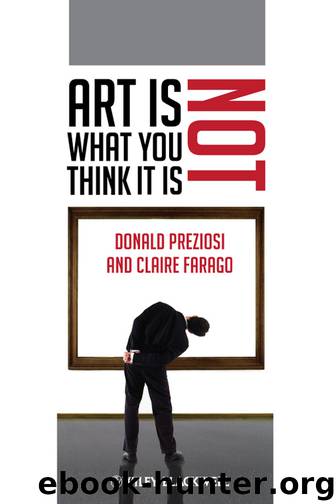Art Is Not What You Think It Is by Donald Preziosi Claire Farago & Claire Farago

Author:Donald Preziosi, Claire Farago & Claire Farago
Language: eng
Format: epub
Publisher: John Wiley & Sons
Published: 2011-11-20T16:00:00+00:00
Collaboration/Participation/One Thing After Another
The question of who or what is (or should be) responsible for artistic production, and under what conditions and for whom, has a long, rich, varied, and well-documented history in diverse academic fields in the Western tradition such as anthropology, aesthetics, art history, archaeology, museology, philosophy, and theology. Aspects of this background were discussed in the First Incursion; here we briefly consider recent developments in rethinking artistry, and in particular the changing identities and functions of the artist and of the work itself.
Since the mid-1990s, artists, critics, and historians have drawn attention to forms of artistry that consciously emphasize dialogic, participatory, or interactive practices in marking a focus on socially engaged practices, as recently summarized in a useful collection of texts published by London’s Whitechapel Gallery.3 For some, emerging changes in artistic practice, exhibition, and marketing have resulted in “a shift from the production of images to the initiation of scenes for the replaying of social relations,” as Nikos Papastergiadis very aptly put it recently.4
Some artists and collaborative groups have been concerned with articulating an alternative symbolic order for representing the viewpoint of the socially marginalized and dispossessed, for example, in giving voice to the perspective of undocumented migrants where the mainstream media and government view characterizes them as a threat to social order. The most deeply invested projects are often those which come from the community itself, such as the Chicano Park murals in Los Angeles, San Diego, Denver, and elsewhere, that began in the 1960s era of the Civil Rights movement and continue today. Operating largely outside the art system as a form of community education and pride, Chicano outdoor murals receive little press or scholarly attention that would situate them as historically significant aspects of contemporary art.5
Papastergiadis offers another compelling example of the ways in which artists play roles in local communities to deal with universal issues of social justice and human needs. The project, entitled Nine (2003), was conceived by the Panamanian artist Brooke Alfaro, who worked with two rival street gangs from Panama City for over a year, gaining the trust of the gangs, their families, and friends. He then proposed to videotape each gang interpreting the same song by El Roockie, already a popular rap artist in the city. Alfaro arranged for a screening of the two videos, side by side, in the contested suburb of Barazza, where a street was closed off and darkened for the occasion, converting an apartment block into a giant public screening space. In the final scene of the video, as the two gangs march toward each other on adjacent screens, one guy tosses a basketball in the direction of the other gang. The ball momentarily disappears as it crosses the gap between the screens and then is caught by a member of the rival gang. Papastergiadis records his own response:
Watching the video documentation of this event, I could see that the art was not just the content on the screen, but also the experience on the street that culminated with the uproar of spontaneous pleasure.
Download
This site does not store any files on its server. We only index and link to content provided by other sites. Please contact the content providers to delete copyright contents if any and email us, we'll remove relevant links or contents immediately.
Ways of Seeing by John Berger(1293)
The Perfumes The A-Z Guide by Luca Turin(1099)
Rembrandt Drawings by Rembrandt(1088)
The Hare with Amber Eyes by Edmund de Waal(1077)
It's Never Too Late to Begin Again by Julia Cameron(981)
On Photography by Walter Benjamin(929)
Natasha's Dance by Orlando Figes(897)
A Month in Siena by Hisham Matar(867)
Why Architecture Matters by Paul Goldberger(827)
Minor Feelings by Cathy Park Hong(817)
The Sound of Paper by Julia Cameron(815)
0062259628 by Sarah Strohmeyer(815)
The Selected Poetry of Rainer Maria Rilke by Rainer Maria Rilke(815)
0544325265 by Brendan Jones(800)
Citizen: An American Lyric by Claudia Rankine(782)
Proust Was a Neuroscientist by Jonah Lehrer(768)
The Death of the Artist by William Deresiewicz(760)
Perfumes the Guide 2018 by Luca Turin(752)
And Our Faces, My Heart, Brief As Photos by John Berger(725)
